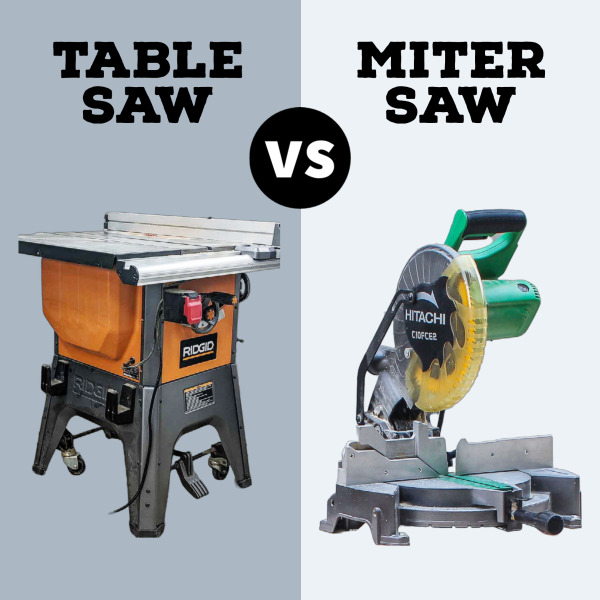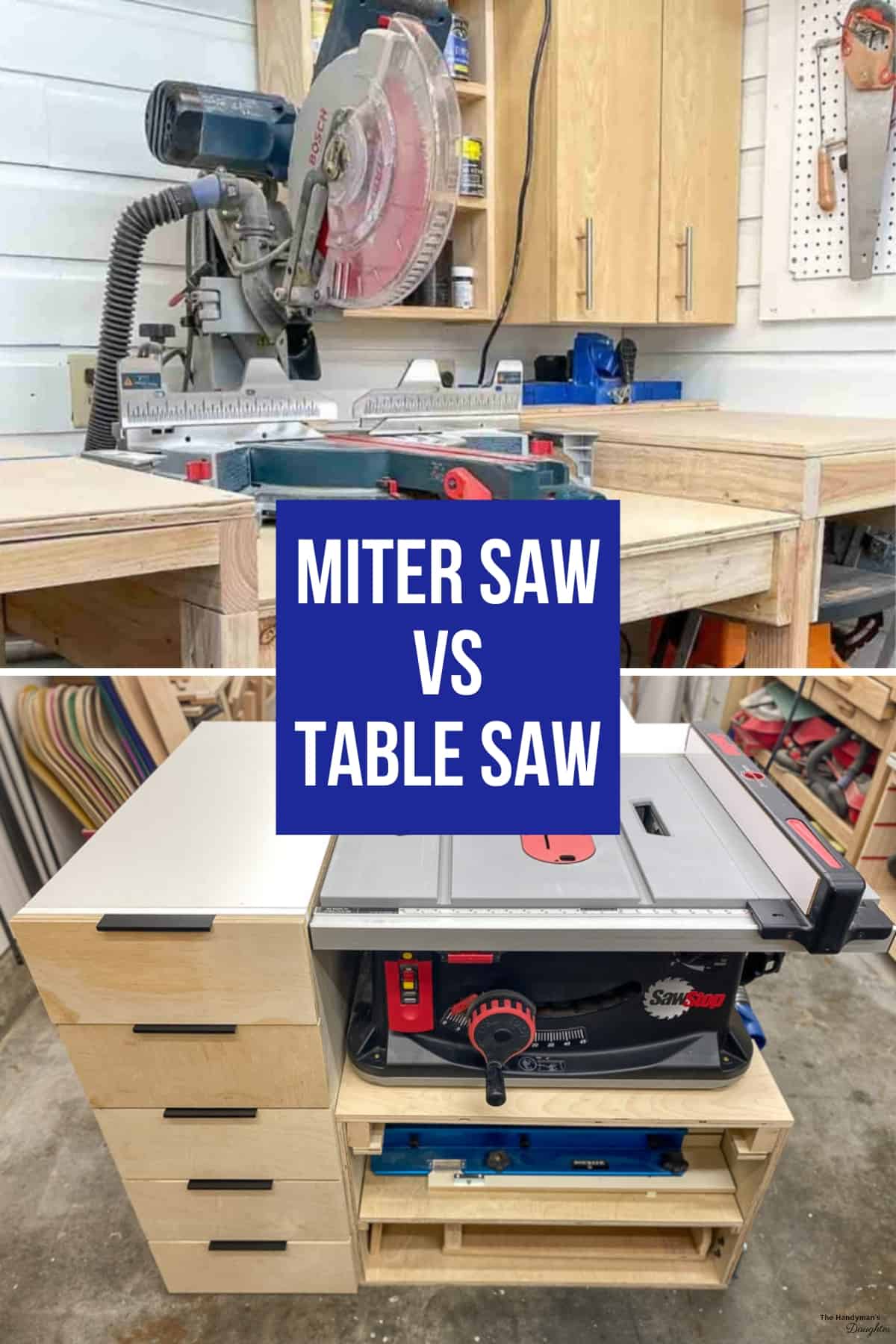What if you have a table saw but wonder if you need a miter saw? It’s a common question among woodworking enthusiasts. Well, let’s dive in and find out! The table saw is a versatile tool, but does it cover all the bases? Let’s explore the benefits and differences to help you make an informed decision.
Wondering if you need a miter saw when you already have a table saw? While both tools are useful for woodworking, they serve different purposes. A miter saw excels at making precise crosscuts and angled cuts, perfect for trim work and framing. On the other hand, a table saw is great for ripping long boards and making straight cuts. So, if you frequently need to make angled or crosscuts, investing in a miter saw would be beneficial. However, if your projects primarily involve straight cuts, a table saw should suffice.

Do I Need a Miter Saw if I Have a Table Saw?
In the world of woodworking and DIY projects, having the right tools is essential. Two popular options for making accurate cuts are the miter saw and the table saw. But do you really need both? In this article, we will explore the differences between these two saws and help you determine if you need a miter saw if you already have a table saw.
The Benefits of a Miter Saw
A miter saw, also known as a chop saw, is designed to make precise angled cuts. It has a pivoting arm that can be adjusted to various angles, allowing you to create perfectly mitered cuts, bevel cuts, or compound cuts. Miter saws are ideal for tasks such as cutting trim, molding, or making angled cuts for picture frames.
One of the key advantages of a miter saw is its versatility. It can handle a wide range of cuts, including crosscuts, miter cuts, and bevel cuts, all in a compact and portable design. The ability to make these cuts quickly and accurately makes a miter saw a valuable addition to any woodworking or DIY enthusiast’s collection of tools.
Additionally, a miter saw often includes a laser guide, which provides a visual indicator of where the blade will cut. This feature can greatly enhance the precision of your cuts, ensuring that you have the desired results every time.
Benefits of a Miter Saw:
- Versatility – Capable of making a variety of angled cuts
- Compact and portable design
- Laser guide for enhanced precision
The Advantages of a Table Saw
A table saw is a powerful tool that features a stationary circular saw blade protruding from a table surface. It is primarily used for making straight cuts, ripping large boards or sheets of plywood, and creating accurate dado cuts. Table saws are indispensable for tasks like building furniture, cutting large panels, or performing general woodworking tasks.
One of the major advantages of a table saw is its ability to handle large pieces of material with ease. The table surface provides a stable and flat platform, which allows for accurate and consistent cuts. Additionally, table saws often have adjustable fences and guides that help you make precise rip cuts and ensure consistent width throughout your workpiece.
Table saws also excel at making repeatable cuts and cutting angles that are parallel to an edge. With the use of accessories like a miter gauge or a sled, you can perform a variety of tasks that are traditionally associated with miter saws, such as crosscutting or making angled cuts.
Advantages of a Table Saw:
- Ideal for making straight cuts and ripping large boards
- Stable and flat table surface for accurate cuts
- Ability to make repeatable cuts and cut angles parallel to an edge
The Verdict: Do You Need Both?
While both the miter saw and the table saw offer unique advantages, the answer to whether you need both ultimately depends on the type of projects you undertake and your personal preferences. If you frequently work with trim, molding, or need to make angled cuts, a miter saw is a valuable tool to have. Its versatility and ability to make precise angled cuts make it a worthwhile investment.
However, if you primarily work with large pieces of material, such as plywood or want a tool that can handle various cutting tasks, the table saw is an indispensable addition to your workshop. Its ability to rip large boards and perform straight cuts with accuracy is unmatched.
Ultimately, having both a miter saw and a table saw in your arsenal provides you with a wide range of capabilities and ensures that you have the right tool for any cutting task that may arise. Consider your project requirements, budget, and available space before making a decision.
Tips for Maximizing the Use of a Miter Saw and a Table Saw
Now that you understand the benefits of both a miter saw and a table saw, here are some tips to help you make the most of these tools:
Tips for Maximizing the Use of a Miter Saw:
- Always secure your workpiece firmly in place, ensuring it cannot move during the cut.
- Use a high-quality blade appropriate for the material you are cutting.
- Consider adding a stand or a workbench with extensions to support longer workpieces.
- Regularly clean and maintain your miter saw to ensure optimal performance.
- Wear appropriate safety gear, such as safety glasses and ear protection, when operating the saw.
Tips for Maximizing the Use of a Table Saw:
- Use a push stick or push block to maintain a safe distance from the blade while cutting.
- Ensure the table saw is properly calibrated and aligned for accurate cuts.
- Consider using a sled for crosscutting or making miter cuts on the table saw.
- Invest in a quality rip fence to ensure straight and precise rip cuts.
- Always follow the manufacturer’s instructions and safety guidelines when operating the table saw.
By following these tips and using both your miter saw and table saw effectively, you can enhance your woodworking projects and achieve professional-level results.
Key Takeaways: Do I Need a Miter Saw if I Have a Table Saw?
- A miter saw is useful for making angled cuts and precise crosscuts, while a table saw excels at ripping long boards and making straight cuts.
- If you frequently work with various angles and need accurate miter cuts, a miter saw can be a valuable addition to your tool collection.
- However, if you primarily work on straight cuts and have limited space or budget, a table saw can fulfill most of your cutting needs.
- Consider your projects and the types of cuts you make most often to determine if investing in a miter saw is necessary for you.
- Remember that both tools have their strengths and limitations, so having both can provide versatility and enhance your woodworking capabilities.
Frequently Asked Questions
When it comes to woodworking, having the right tools can make all the difference. If you already have a table saw, you may be wondering if you need to invest in a miter saw as well. In this FAQ section, we’ll address common questions about whether a miter saw is necessary when you already have a table saw.
Q: What is the main difference between a miter saw and a table saw?
A: While both miter saws and table saws are used in woodworking, they serve different purposes. A miter saw is designed for making precise crosscuts and miter cuts at various angles. It is ideal for tasks such as cutting trim or making angled cuts for frames and joints. On the other hand, a table saw excels at making straight rip cuts and bevel cuts. It is commonly used for cutting large sheets of plywood or other materials along their length.
Q: Can a table saw replace a miter saw?
A: While a table saw can perform some of the functions of a miter saw, it cannot entirely replace it. Miter saws have the ability to make accurate crosscuts at specific angles, which can be challenging to achieve with a table saw. If you frequently work with angled cuts or need precise miter cuts, investing in a miter saw will greatly enhance your woodworking capabilities. However, if you primarily work with straight cuts or rip cuts, a table saw can handle those tasks effectively without the need for a miter saw.
Q: Are there any advantages to using a miter saw over a table saw?
A: Yes, there are several advantages to using a miter saw alongside a table saw. Miter saws are often more portable and compact, making them easier to transport and set up at job sites. Their design also allows for quick and precise angle adjustments, making them ideal for projects that require frequent angle changes. Additionally, miter saws are often safer when it comes to making crosscuts, as the saw blade remains stationary while the workpiece is moved. This reduces the risk of accidents and can provide increased peace of mind.
Q: Can a miter saw perform the same tasks as a table saw?
A: While a miter saw can perform some similar tasks to a table saw, it is not designed for all the same functions. Miter saws excel at making crosscuts, miter cuts, bevel cuts, and compound cuts with ease and precision. They are perfect for tasks such as cutting trim, making picture frames, or creating angled joints. However, they are not ideal for ripping large sheets of material or making long, straight cuts like a table saw can. If you require both types of cuts in your woodworking projects, it is recommended to have both a miter saw and a table saw in your workshop.
Q: Do I need a miter saw if I already have a table saw?
A: The need for a miter saw if you already have a table saw depends on the types of projects you undertake. If you frequently work with angled or beveled cuts, or if you need precise crosscuts for trim or joints, investing in a miter saw is a wise choice. However, if your projects primarily involve straight cuts or rip cuts, a table saw can handle those tasks effectively. It is important to assess the specific requirements of your woodworking projects to determine if a miter saw would be a valuable addition to your tool collection.

Should You Buy A Miter Saw? – Beginner Woodworker’s guide
Summary
So, do you really need a miter saw if you already have a table saw?
Well, it depends on what kind of projects you plan to tackle.
While both tools are great for making cuts, a miter saw offers more versatility. It can make angled cuts with precision, perfect for tasks like trimming moldings or making photo frames.
However, if you mainly work on straight cuts and need a large work surface, a table saw is a solid choice. It’s great for ripping boards and handling larger pieces of wood.
So, think about what you’ll be using the tools for and consider your budget before making a decision. Happy woodworking!
